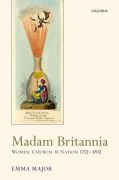
Using Britannia as a central figure, this book explores the neglected relationship between women, church, and nation. Drawing on a wealth of manuscript, printed, and graphic material, Emma Major argues that Britannia became established as an emblem of nation from 1688 and gained in importance over the following century. Madam Britannia: Women, Church, and Nation, 1712-1812 explores thecomplex and fascinating relationship between women, Protestantism, and nationhood. Opening with a history of Britannia, this book argues that Britannia becomes increasingly popular as a national emblem from 1688 onwards. Over the eighteenth century, depictions of Britannia become exemplary as well as emblematic, her behaviour to be imitated as well as admired. Britannia takes life during the eighteenthcentury, stepping out of iconic representation on coins, out of the pages of James Thomson's poetry, down from the stage of David Mallett's plays, the frames of Francis Hayman and William Hogarth's paintings, and John Flaxman's monuments to enter people's lives as an identity to be experienced.One of the key strands explored in this book is Britannia's relationship to female personifications of the Church of England, which themselves often drew on key Protestant Queens such as Elizabeth I and Anne. But during the eighteenth century, Britannia also gained cultural status by being a female figure of nationhood at a time when Enlightenment historians developed conjectural histories which placed women at the centre of civilisation. Women's religion, conversation, and social practice thushad a new resonance in this new, self-consciously civilised age. In this book, Emma Major looks at how narratives of faith, national identity, and civilisation allowed women such as Elizabeth Burnet, Elizabeth Montagu, Catherine Talbot, Anna Laetitia Barbauld, Hester Lynch Thrale Piozzi, and HannahMore to see themselves as active agents in the shaping of the nation. INDICE: Introduction. Madam Britannia The History of Madam Britannia Performing Madam Britannia and The Blessing Of Example Protestant Nunneries, Polygamy, and Christian Heroes The Church of England, Methodism, and 'the province of public virtue The Politics of Paradise: Insurrection, Sunday Schools, and Elizabeth Vesey's Dragon 'A free Government & Religion rational & pure': Two versions of nation The Contrast I: Serpents, Rocks, and the Gates of Hell The Contrast II: Bruising the Serpent's Head, the Little Sister, and Christian Professions Epilogue Bibliography
- ISBN: 978-0-19-969937-7
- Editorial: Oxford University
- Encuadernacion: Cartoné
- Páginas: 384
- Fecha Publicación: 01/12/2011
- Nº Volúmenes: 1
- Idioma: Inglés
